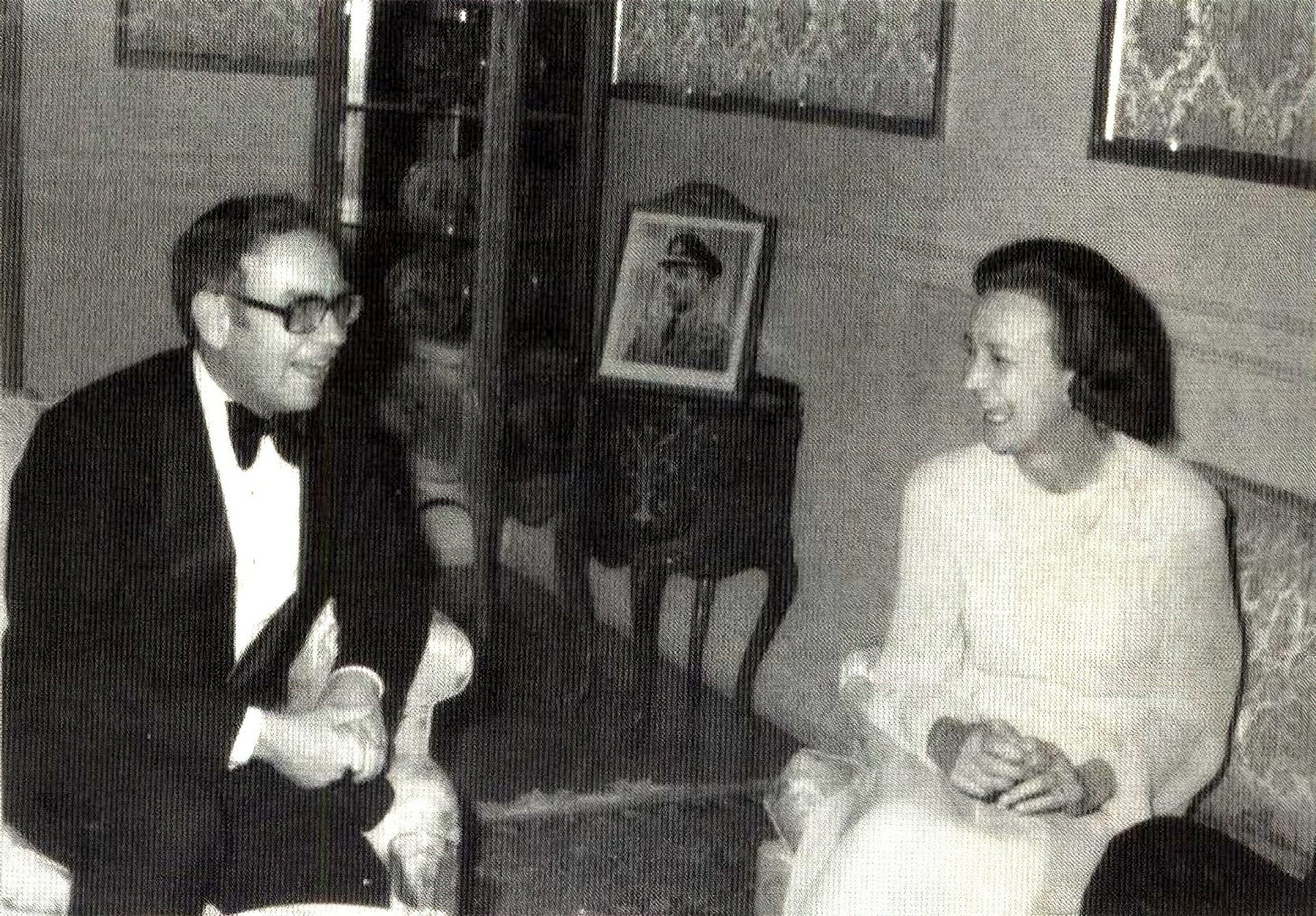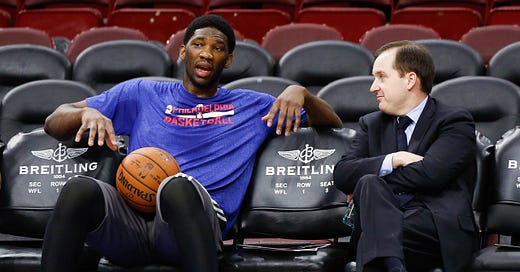This post is a prelude to my upcoming investor letter which will be out next week.
In 2006, the Philadelphia 76ers face an undeniable truth: The Allen Iverson era is ending. Iverson was the first 1996 NBA draft pick, ascended to MVP status quickly and electrified the city. However, over time, his discipline wanes. He indulges in the city’s nightlife, shows up to practice late and neglects his workouts and diet (culminating in his iconic 2002 “We Talking About Practice” rant where he says the word “practice” 22 times, see below).
A decade after his draft, Iverson is traded to Denver, marking the beginning of a new chapter for the Sixers. The team’s owner, Comcast, tries to shop the franchise to controversial real estate developer Charles Kushner before selling it to David Blitzer and Josh Harris for $280m in 2011.
Harris, a Drexel Burnham Lambert alumnus and co-founder of PE firm Apollo, knows that significant changes are needed to revive the team. One of his first and most controversial moves is acquiring L.A. Lakers center Andrew Bynum against giving up Andre Iguodala (the team’s best player), Nikola Vučević and Moe Harkless. Bynum arrives in Philadelphia with high hopes but suffers an unforeseeable knee injury while bowling in his free time. He ends up playing not a single game for the 76ers and the trade’s outcome is a disaster for the new ownership.
Subsequently, Harris seeks a talented new general manager with hopefully greater success in making these calculated bets. Despite his frustration with a single decision’s outcome, Harris emphasizes the following at a press conference, foreshadowing his process-over-outcome philosophy:
“If I had to make that decision again, I’d make it again. Things don’t always work out. You just make good decisions and over time they work out.”
In 2013, 35-year-old Sam Hinkie, a former PE associate with an MBA from Stanford, is presented as the Sixers’ new general manager. Hinkie is known for progressing the basketball analytics movement at the Houston Rockets and at his first press conference in Philadelphia, he echoes Harris, stating: “We talk a lot about process here – not outcome.” He later adds that “I don’t even care if the shot goes in or not. I’m all about, should it go in. I can live with randomness […] but I just want us to play the odds all the time.”
Hinkie believes his ability to wield the “longest lens in the room” gives him an edge over competitors, allowing him to focus on the best outcomes 5 or 10 years ahead rather than managing for short-term gains. To win another championship, the 76ers must acquire a new superstar and Hinkie knows that an effective way to do so is through the annual NBA draft.
Each year, the 60 best eligible college and international players enter the league through the draft, with teams picking players in reverse order of their previous season performance. The worse a team’s prior year record, the better its chances at winning a high pick, ideally the no. 1 pick. Reflecting on the Sixers’ mediocre roster, Hinkie trades all remaining valuable players and intentionally fields less competitive teams to secure high draft picks, hoping to land a franchise-altering talent. The rebuilding strategy is quickly dubbed 'The Process' and fans brace for a dire losing streak in the short term in exchange for the chance at a richer future.
From here, things get ugly. During the 2013-14, 2014-15 and 2015-16 seasons, the Sixers win fewer than 20 out of their 82 total regular season games, resulting in the worst three-year stretch in NBA history under Hinkie’s rebuilding approach. The 2015-16 season, with a 10-72 record, is particularly brutal as the team loses 29 of its first 30 games, the worst 30-game start ever.
Unsurprisingly, the Sixers’ open tanking doesn’t just create fans; it also sparks a showdown between Hinkie supporters and the team’s ownership, which faces mounting pressure from the NBA Commissioner and business partners to improve short-term results. In December 2015, Harris hires Jerry Colangelo as chairman of basketball operations, effectively undermining Hinkie’s authority, leading to his resignation in April 2016.
As the news breaks, disgruntled Hinkie supporters rally behind the slogans Hinkie Died for Our Sins and Trust the Process while other fans, alienated by the three-year losing streak, feel relief.

No matter one’s perspective, right after Hinkie’s departure, the struggles of 2013-15 finally pay off as the Sixers win the no. 1 draft pick in 2016. They select Ben Simmons, which together with their 2014 third pick, Joel Embiid, nets the team two young superstar players. 'The Process' as one of the most aggressive rebuilds in NBA history combined with Hinkie’s patience let the Sixers return from a hopeless franchise to a consistent playoff contender.
In 2019, they are one shot away from entering the Conference Finals but Raptors superstar Kawhi Leonard scores a miracle buzzer-beater in Game 7 of the semifinals.
In the following years, a mix of bad luck and poor decision-making by the new front office ultimately prevents 'The Process' from delivering another long-awaited championship to Philadelphia.1
Process + Patience = A Superpower
I’m recalling this story because of the many parallels between Hinkie’s probabilistic, long-term thinking and what it requires to manage a fund successfully through different cycles.
Not every investment decision will be a success due to numerous risk factors in every thesis. However, over a long enough period and with a solid decision-making process, aggregate results should be compelling. I subscribe to Hinkie’s view that using a longer time horizon than everybody else can be a competitive advantage, in pro sports as in investing. While I often find it nearly impossible to develop a variant perception of how high earnings of a well understood company will be in the next quarter, competing for relevant information to form an educated guess about earnings 5 or 10 years ahead is far less crowded with a higher chance of success. A telling statistic in this regard is that the average holding time for stocks trading on the NYSE has come down from 8 years in 1960 to less than 4 months today.
A final observation from Hinkie’s tenure with the Sixers is that he had to prove his ability to delay gratification. The team’s record would not improve until after a three-year investment phase, during which short-term gains were sacrificed for high draft picks. Similarly, in investing, buying shares of an unpopular but economically strengthening company can also lead to short-term underperformance, as there is no guarantee that the share price won’t decline further, making the bargain even bigger.
In these moments, it's a fund advisor’s job to catch the proverbial falling knife rather than avoid it. One would be remiss not to start acting as soon as an asset becomes cheap, even if the price of that bargain is an emotional one – accepting discomfort during short-term underperformance and risking looking foolish.
Berkshire's 1970s Washington Post Investment
A well-known example of a 'falling knife' investment is Berkshire’s acquisition of 10% of the Washington Post Company (WPO) during the 1973-74 market crash, summarized in their 1993 letter:
“In 1973, we purchased our 10% stake in WPO for about $10m. Our holding now garners $7m a year in dividends and is worth over $400m. At the time of our purchase, we knew that the economic prospects of the company were good. But equally important, Charlie and I concluded that Kay would prove to be an outstanding manager and would treat all shareholders honorably.”
Katharine “Kay” Graham successfully led WPO from 1973 to 1991 after her husband, Philip Graham, committed suicide. During her tenure, WPO delivered annual returns of 20% over two decades, resulting in a 40-fold increase. A blowout success that every institutional investor should have eagerly picked up in 1973, right? Wrong!

When Berkshire bought into WPO, it was an unpopular stock that had just dropped from $37 to $16. At the time, WPO had a market cap of $80m and based on a 1973 operating profit of $26m, the company’s intrinsic value was estimated to be around $400m by many investors (not just by Buffett and Munger). An interesting but lesser-known fact about this investment is that every large institution selling WPO shares to Berkshire in 1973 agreed that the company was worth at least 3 or 4 times what they were selling it for. There was no information asymmetry, nor did Berkshire have a superior assessment of the company’s intrinsic value compared to everyone else.

The sole reason sellers still parted with WPO shares so cheaply was their belief that the stock would keep declining next quarter. The prevailing narrative at the time was that political retaliation against the newspaper would only intensify after its leading role in uncovering the Watergate scandal. Even more intriguing is the fact that the sellers were initially right – WPO shares didn’t just decline for another quarter but for the next eight(!) before bottoming out and becoming a decades-long compounder.
The takeaway: Patience has always been a superpower. As time horizons and attention spans continue to shrink, the behavioral strength to delay gratification, withstand short-term volatility and adhere to a disciplined investment process on the path to a richer future will become an increasingly valuable edge.
[end of asbtract]
…
The full investor letter—a five-year review of the fund’s progress—will be sent to clients next week.
If you don’t want to miss anything, you can follow me on Twitter: patient_capital
To learn more about the investment fund I advise or access my previous annual letters to investors you can visit: https://www.patient-capital.de/fonds
This document is for informational purposes only. It is no investment advice and no financial analysis. The Imprint applies.
NBA writer Yaron Weitzman has greatly summarized Hinkie’s tenure with the Sixers in his book “Tanking to the Top”





